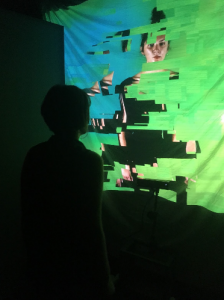Close (but not too close)
|
By Jess Medenbach, Emily Saltz, Irene Alvarado, Caroline Hermans Overview: Close (but not too close) explores the boundaries of personal—and technological—space. The viewer’s relationship with the projected woman changes depending on their proximity to her, leading them to work with her to find just the right distance for comfort. Video: https://vimeo.com/183056679 Tech: A Kinect is used to track the viewer’s distance to the video projected on a sheet. The OSC distance values are divided into four ranges, each range triggering a different sets of video clips and glitch effects to play in a Processing sketch. The OSC distance ranges are also sent to Max MSP, which triggers one of three sounds to play. Experience: To start, a single viewer enters an enclosed space and is met by an overpowering figure of a woman in a black dress and a visible Kinect sensor. She’s not in any recognizable physical space, but surrounded by slowly wavering color tv pixels, swimming around in a psychedelic swirl of blue and green. You’re positioning yourself not just within her internal world, but also transparently in relation to the Kinect. From a distance, she’s uncomfortable, looking away distractedly over a soundtrack of choppy cell phone interference. A physical pathway dares the viewer to come closer. Walking forward, the viewer’s relationship with the woman changes. As you walk closer, she directs her stare to you, and resonant major-key drone hums. The video experience is slightly different for each viewer. At this comfortable distance, she might smile, or spread her arms to embrace you. But walk further and the viewer crosses into the “too close” territory. The woman glitches (which is done using a Processing effect), feedback sounds echo, and the red button of the Kinect stares you in the face. Future directions: We have many ideas about how we could expand this project in the future to offer other possibilities for what it means for people to find a shared comfort space. Currently, the metaphysical aesthetics—the Lynchian woman in a black dress (who may feel more like a fantastical, symbol of a woman than an actual vulnerable person), and the artificial psychedelic background—suggest that the viewer is dealing with distance in relationships in the abstract. However, as a team we didn’t intend to make an essentialist point about there being definitive distances for inducing comfort. It would be interesting to explore how these distance triggers might change for different characters. In addition, currently she’s reacting to you, but you can only react to her in a narrow way by walking back and forward. That means once you’ve figured out what makes her comfortable/uncomfortable, there are no more surprises (though the clips change up slightly for each state). It may be valuable to think about other dimensions of movement and expression that the viewer could you to interact either with the projected figure, or even another viewer of the piece. |


